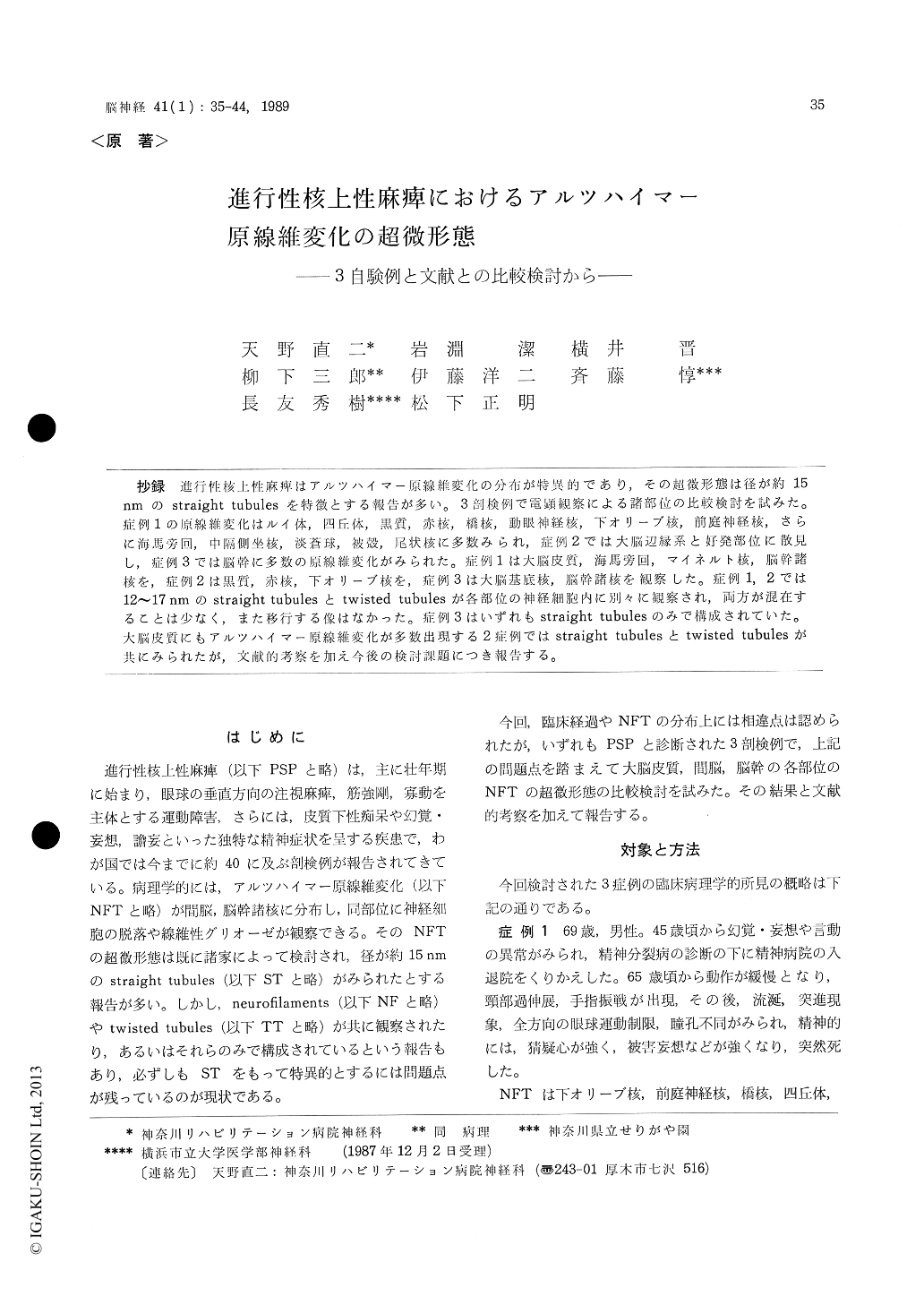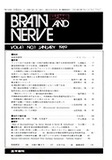Japanese
English
- 有料閲覧
- Abstract 文献概要
- 1ページ目 Look Inside
抄録 進行性核上性麻痺はアルツハイマー原線維変化の分布が特異的であり,その超微形態は径が約15nmのstraight tubulesを特徴とする報告が多い。3剖検例で電顕観察による諸部位の比較検討を試みた。症例1の原線維変化はルイ体,四丘体,黒質,赤核,橋核,動眼神経核,下オリーブ核,前庭神経核,さらに海馬旁回,中隔側坐核,淡蒼球,被殻,尾状核に多数みられ,症例2では大脳辺縁系と好発部位に散見し,症例3では脳幹に多数の原線維変化がみられた。症例1は大脳皮質,海馬旁回,マイネルト核,脳幹諸核を,症例2は黒質,赤核,下オリーブ核を,症例3は大脳基底核,脳幹諸核を観察した。症例1,2では12〜17nmのstraight tubulesとtwisted tubulesが各部位の神経細胞内に別々に観察され,両方が混在することは少なく,また移行する像はなかった。症例3はいずれもstraight tubulesのみで構成されていた。大脳皮質にもアルツハイマー原線維変化が多数出現する2症例ではstraight tubulesとtwisted tubulesが共にみられたが,文献的考察を加え今後の検討課題につき報告する。
Progressive supranuclear palsy (PSP) is charac-terized by symptoms of disturbance of eye move-ment, nuchal rigidity, parkinsonism and subcorti-cal dementia. Its pathology reveals that Alzhei-mer's neurofibrillary tangles (NFTs) are situated especially in the nuclei of basal ganglia and brainstem. It has been pointed out that NFTs observed in PSP are composed of straight tubules, the width of which is about 15 nm.
This report is to reappraise the ultrastructure of NFTs observed in three cases of PSP. They are case 1; 69-year-old male, case 2; 62-year-old female and case 3 ; 65-year-old male. The clinical features of three cases were characterized by above-mentioned symptoms. Many NFTs were observed in brainstem of case 1 and 3. NFTs seen in brainstem of case 2 were in a small amount. In case 1 and 2, there were many NFTs in cerebral cortex, especially in parahippocampal gyri and other limbic areas.
We examined the portions of frontal cerebral cortex, parahippocampal cortex, the basal nucleus of Meynert, oculomotor nucleus, substantia nigra,pontine nuclei and locus caeruleus of case 1, substantia nigra, red nucleus and inferior olivary nucleus of case 2, and Ammon's horn, globus pallidum, subthalamic nucleus, substantia nigra, oculomotor nucleus, pontine nuclei, locus ceruleus and inferior olivary nucleus of case 3.
Ultrastructurally, NFTs of frontal cortex of case 1 consisted of twisted tubules and those of hippocampal and parahippocampal cortici of case 1 consisted of straight and twisted tubules, being observed separatedly in neurons. The NFTs of brainstem of case 1 and 2 were mainly composed of 12-17 nm straight tubules, and twisted tubules occasionally intermingled with straight compo-nents. In locus ceruleus of case 1, a single st-raight tubule could be seen in the bundles of twisted tubules. NFTs of case 3 were composedof only straght tubules, the width of which was about 15 nm. Twisted components were not ob-served in neurons of each nuclei of case 3.
The characteristic ultrastructure of NFTs in PSP has been an appearance of straight tubules, however, twisted tubules were occasionally ob-served in this study. There are several case reports which demonstrated an appearance of both straight and twisted components. It is easily presumed that the process of aging takes part in the ac-cumulation of twisted fibrils. However, it is now under consideration why twisted tubules are also observed in PSP. To summarize this study, the cases with many NFTs observed in widespread cerebral cortex may have a tendency to show both straight and twisted tubules.

Copyright © 1989, Igaku-Shoin Ltd. All rights reserved.


